This ever-roaring giant not only connects two North American countries, but more importantly, it mesmerizes anyone standing near it with its strength, power, and majesty.
Niagara Falls is the undisputed star of Niagara Falls State Park, the oldest state park in the USA. But this waterfall, located on the border between Canada and the United States, is not only famous on one continent. After all, this point on the map, which has been captivating visitors for centuries, is one of the most iconic and spectacular natural wonders in the world.
Formation of the Waterfalls
More than 12,000 years ago, the period known as the Ice Age began to draw to a close. This marked the beginning of the formation of the world’s most famous waterfall. It was then that ice began to melt, and massive volumes of water formed the Niagara River, which gradually carved a valley and shaped the waterfalls. Initially, the cascades were located near the present-day town of Lewiston in New York State, but the force of erosion caused them to shift about 11 kilometers south, right to where they are now. And this is likely not the end of changes to the appearance of the falls, as the processes shaping this natural wonder are still slowly at work in its ongoing formation.
How was the beauty and power of Niagara Falls discovered?
The likely first lucky witnesses of Niagara Falls’ power were the indigenous peoples of North America. However, the first explorer credited with documenting the existence of this water colossus is the French priest, Father Louis Hennepin. After his expedition in 1678, he published a book that brought the attention of the entire Western world to this natural gem of America.
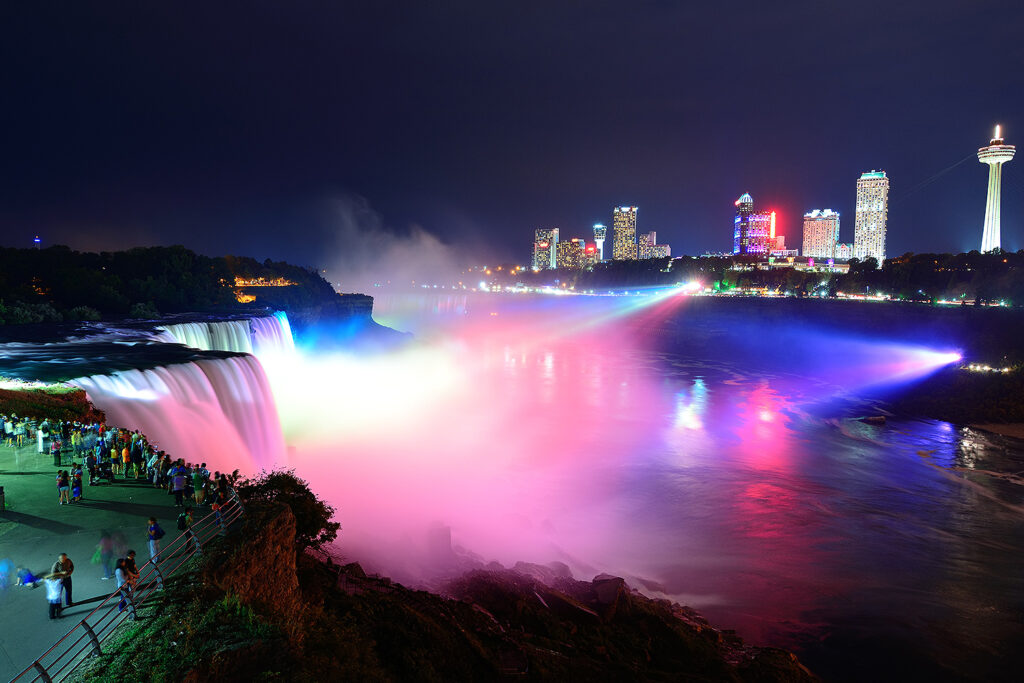
Since the 19th century, tourists have been able to reach the vicinity of the cascades by train, and more and more people were eager to take this journey. One notable influence was Jerome Bonaparte, Napoleon Bonaparte’s younger brother, who spent his honeymoon at Niagara Falls with his American fiancée in 1804. It is said that this not only boosted tourism in the area but also sparked the now-popular tradition of spending honeymoons surrounded by the splendor of these mighty waterfalls.
A Source of Hydropower
It took several more decades before the world discovered another, more practical side to the breathtaking cascades. In 1895, the world’s first large-scale hydroelectric power station was opened at Niagara Falls. However, it initially used a direct current (DC) system. This changed just a year later, thanks to the famous engineer Nikola Tesla. He demonstrated that using his alternating current (AC) motor, he could transmit electrical power from Niagara to Buffalo, New York. This was the first instance of electricity being sold as a commodity, and the power station, which began this revolution, is still operational today.
GOOD TO KNOW: Today, this natural wonder produces millions of kilowatts of electricity shared between the United States and Canada. Nearly half of the water from the falls is diverted to power three hydroelectric plants operating at Niagara.
Structure of Niagara Falls
While many people associate the world’s most famous cascade primarily with the United States, Niagara Falls is actually the pride of two North American countries. Situated on the border between the United States and Canada, this natural wonder consists of three separate waterfalls: the Canadian Horseshoe Falls, and the neighboring American Falls and Bridal Veil Falls on the U.S. side.
Niagara Falls is surrounded by urban areas belonging to two cities, both of which share the same name despite being in different countries: Niagara Falls. The water cascading down these falls comes from the Niagara River, which connects Lake Erie and Lake Ontario. Despite being one of the world’s most recognizable natural landmarks, the Niagara River is relatively short at just 58 km in length. Nonetheless, the power of the water, which drops nearly 100 meters in total elevation, is undeniable.
A closer look at Niagara Falls
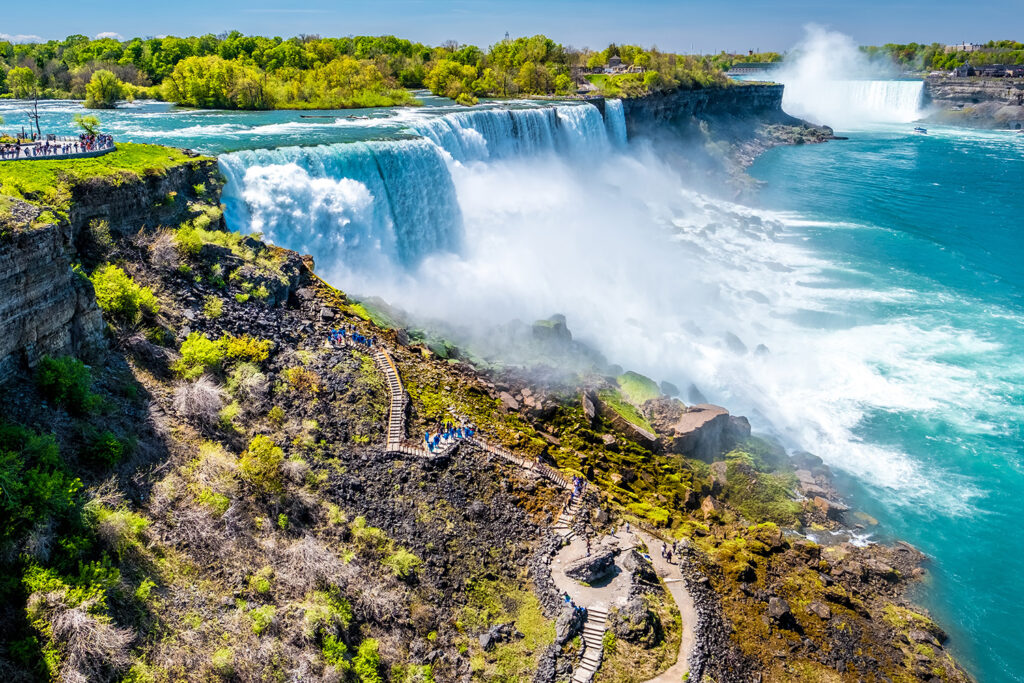
The largest and most impressive of the waterfalls is the Horseshoe Falls, located on the Canadian side. It spans between Terrapin Point on Goat Island and Table Rock in Canada, with its iconic horseshoe shape giving it its name. Horseshoe Falls stretches about 790 meters wide, with water plunging nearly 57 meters and striking the base with a force of 2,509 tons. This waterfall handles about 90% of the Niagara River’s flow, which amounts to more than 2 million liters of water per second!
On the American side of the river, Luna Island is flanked by the American Falls and the smallest of the three, the delicate Bridal Veil Falls. These falls drop from a height of about 34 meters, with water hitting the river below with a force of 280 tons. Though smaller than their Canadian counterpart, these falls have captivated many visitors, with some even finding the American Falls and Bridal Veil Falls to be the most enchanting part of Niagara’s allure.
Fauna and flora in the Niagara Region
For nature enthusiasts, the Niagara Falls area offers much more than just the waterfalls. The surroundings are home to a variety of fish species, including the endangered lake sturgeon, which resides in the lower Niagara River. Additionally, it is a haven for bird watchers, with a variety of avian species calling the area home. Notable protected species such as the peregrine falcon and the American bald eagle can be spotted, alongside more common birds like gulls and waterfowl.
The Niagara River Gorge is also home to 14 rare plant species, some of which are threatened. Many of these plants are located on Goat Island. Historically, the area hosted 140 of the 170 native tree species found in western New York. Today, the total number of documented plant species on Goat Island exceeds 600.
Goat Island and other islands
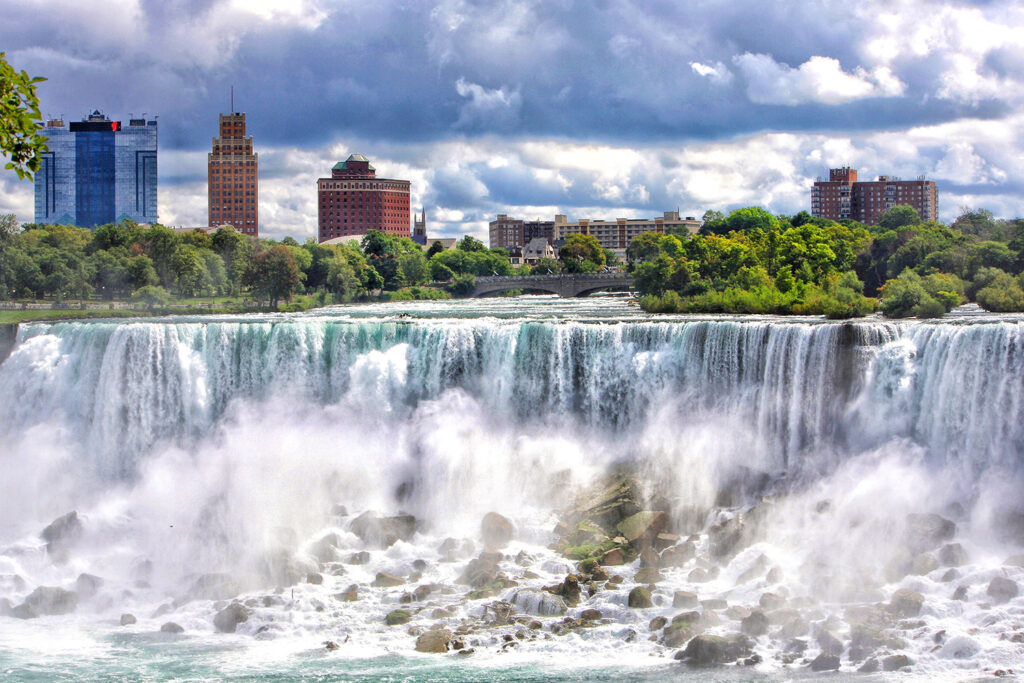
A large number of visitors prefer exploring the park’s natural beauty for free, and no such visit is complete without a stop at the famous islands. The largest of these is Goat Island, which, despite its name, no longer has goats. The name originates from the animals once raised there by John Stedman, the original landowner. Today, the island boasts numerous trails, viewpoints, and picnic spots. Visitors can also find dining options, souvenir shops, and parking facilities on the island. Additionally, Goat Island offers access to the Cave of the Winds, but the main highlight is Terrapin Point, one of the most popular free viewing spots for Horseshoe Falls.
Luna Island, which separates the American Falls and Bridal Veil Falls, also serves as a scenic viewpoint. Similarly, the Three Sisters Islands offer unique vantage points, each with its own microclimate and distinct floral character. Connected by pedestrian bridges, these islands allow visitors to walk across and enjoy different perspectives of the rushing rapids and the natural beauty surrounding them.
Attractions at Niagara Falls
On both the Canadian and American sides of Niagara Falls, visitors can find additional attractions that enhance the experience and make a trip to this natural wonder even more memorable.
Cave of the winds
Why is this attraction one of the most popular among tourists? Because it offers the chance to get as close as possible to one of the waterfalls, Bridal Veil Falls. This ticketed experience begins at The World Changed Here Pavilion, a museum space that uses audiovisual materials to tell the story of the park’s creation and significant events in its history.
After exploring the pavilion, visitors are led to an elevator that descends down the cliffside to the base of the Niagara Gorge. Upon exiting, they are provided with special ponchos and guided along wooden walkways that bring them within arm’s reach of the cascading waters of Bridal Veil Falls. And yes, that’s literally within arm’s reach! For the truly brave, there’s Hurricane Deck, the highest platform where visitors can fully immerse themselves in the mist and powerful spray of the waterfall.
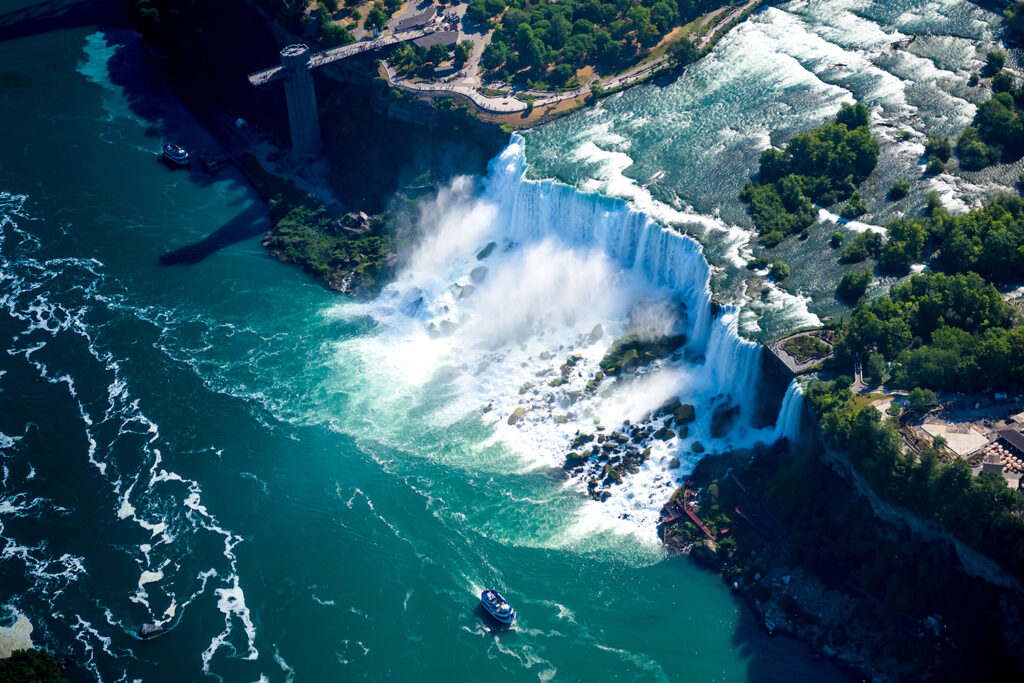
FUN FACT: In the 19th century, there was a natural rock formation resembling a cave where today’s walkways stand. People could stand at the base of the falls and watch the water from inside this cave-like structure. This is where the name “Cave of the Winds” originated, though the cave itself collapsed in the early 1900s. However, the name stuck, and it continues to be used today despite the absence of the actual cave.
Maid of the Mist Boat Tour
Since 1846, tourists visiting Niagara Falls have been able to hear the thunderous roar of the falls up close thanks to the Maid of the Mist boat tour. This two-tiered excursion boat departs from the Observation Tower and takes passengers on a thrilling journey near the base of the American Falls, with a route that also approaches the swirling waters of Horseshoe Falls. Before boarding, each passenger is given a commemorative poncho, but even that won’t fully shield you from the thick mist rising from the falls. If you’re on the Canadian side, look out for the Hornblower boat, which offers a similar experience to the Maid of the Mist.
FUN FACT: Fans of iconic American TV shows might find the sight of the two-deck boat approaching the churning waters strangely familiar. That’s because one of the most memorable scenes from the sitcom “The Office” – the wedding of Jim and Pam – was filmed aboard the Maid of the Mist.
Observation Towers
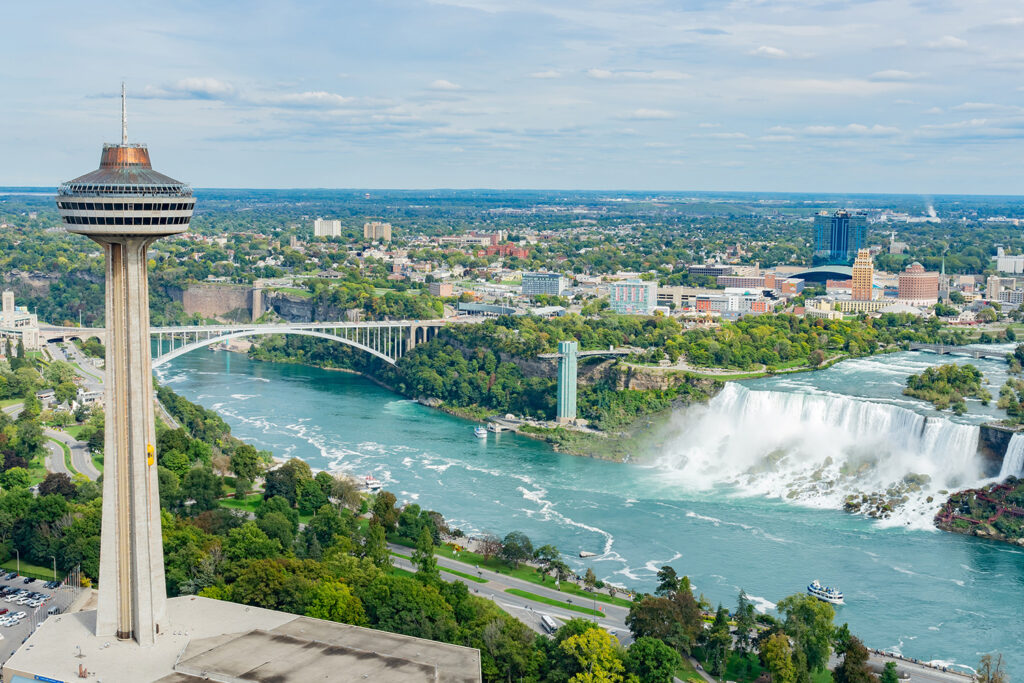
These attractions are unique in offering panoramic views of all three Niagara Falls. The Niagara Falls Observation Tower on the American side provides an uninterrupted vantage point over the wild cascades, while also allowing visitors to spot many of the bird species that call the area home. Across the river on the Canadian side, the Skylon Tower, standing over 200 meters (650 feet) above Horseshoe Falls, offers access to both indoor and outdoor observation decks. Visitors can also enjoy a rotating restaurant, where they can dine while taking in breathtaking, panoramic views of the falls.
Panoramic Tour Among the Waterfalls
Niagara Falls State Park also caters to visitors with limited mobility or those who prefer not to walk long distances. A special panoramic trolley offers a scenic tour of the area, showcasing all the waterfalls while taking passengers close to the Niagara River Gorge and the key sights on Goat Island. Tickets for this ride are just a few dollars, but the downside is that this attraction is quite popular among tourists, so you might have to wait your turn to board.
Additional Attractions
The list of activities at Niagara Falls doesn’t stop there. For a burst of adrenaline, consider taking to the skies with a helicopter tour over the falls, offering breathtaking aerial views of the park. For even more thrills, head to the Canadian side of the river, where you can experience a heart-pounding ride on a zipline that reaches speeds of over 70 km/h (43 mph) while flying past the majestic Horseshoe Falls.

On the same side of the river, embark on a tour called Journey Behind the Falls, which takes you on a unique walk through tunnels carved 38 meters (125 feet) deep into the rock behind the waterfalls. This 45-minute tour offers a rare opportunity to view Niagara Falls from the inside and includes access to observation decks located directly beneath the powerful cascade, giving you an up-close and unforgettable perspective.
Hiking Trails
Many visitors may not realize that the Niagara Falls area is not just a destination for thrill-seekers and photographers but also a haven for those who can’t imagine a vacation without long walks. There are numerous scenic routes, not just on the islands, but also along the river, perfect for trekking amidst stunning landscapes.
The Niagara Gorge Trailhead Center is the starting point for several hiking paths. Here, you’ll find both easy, enjoyable trails like the Great Gorge Scenic Overlook and Shoreline Trail, as well as more challenging routes such as the Devil’s Hole Rapids Trail, which takes about 2.5 hours to complete.
For true adventurers seeking a challenge, the Whirlpool Rapids Trail is the one to choose. This path descends steeply into the gorge, where you’ll be rewarded with breathtaking views of the vibrant Niagara River and the surrounding Whirlpool State Park. Even seasoned hikers should be cautious here, as the river’s strong currents and slippery rocks along some sections can make the journey especially treacherous.
When to Visit Niagara Falls?
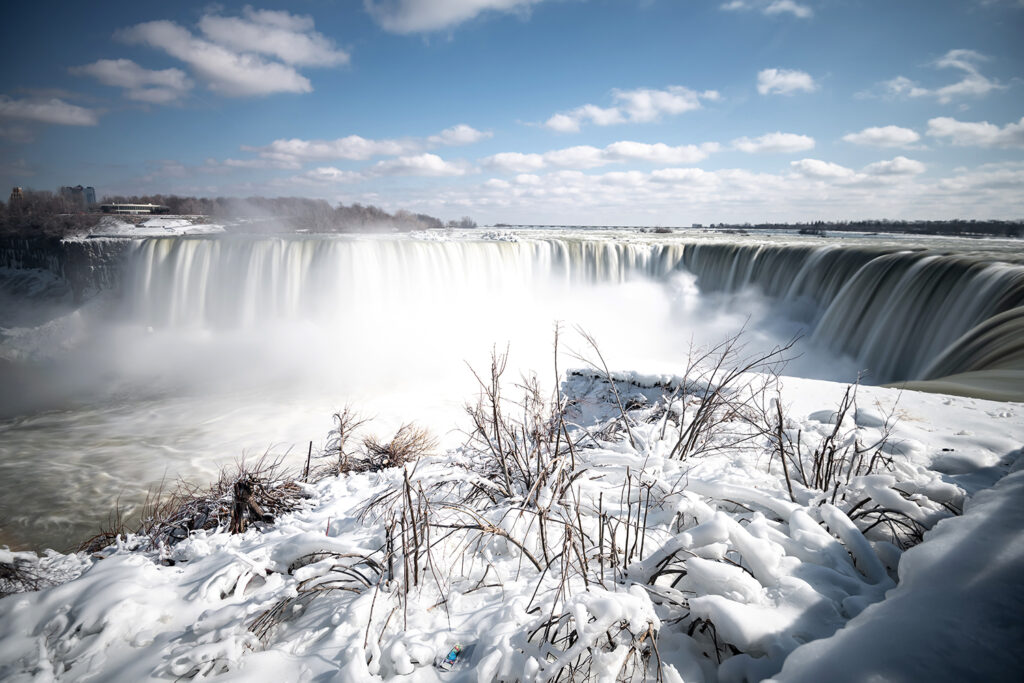
The Niagara Falls State Park is open 365 days a year, and access to the park and views of the falls are always free. However, depending on when you visit, you’ll experience the falls in different ways. During the day, you’ll be able to see the water’s powerful churns with greater clarity, making it ideal for photography. In the evening, though, the falls transform into a magical sight, thanks to colorful illuminations that light up from dusk until midnight. On select weekends, there are also fireworks displays, adding an extra touch of enchantment and drawing even more visitors.
As for the best season to visit, summer is the most popular time, with the cool mist from the falls providing refreshing relief from the heat. It’s hard to resist the allure of a boat ride during this season. However, if you prefer fewer crowds, spring and autumn are excellent alternatives. The park is bursting with vibrant colors, and the weather is still pleasant enough to enjoy hiking and other activities.
Winter, on the other hand, turns Niagara Falls into an icy wonderland, offering a unique perspective of the waterfalls. While some of the classic attractions close for the season, new opportunities arise. You can enjoy snowshoeing near the frozen cascades or warm up with hot chocolate at the Visitor Center, all while admiring the falls in their breathtaking icy form.
Trip Planning
Due to high demand, it’s best to purchase tickets for attractions at Niagara Falls State Park well in advance for a specific date. You can do so on platforms like this site. There, you’ll find not only tickets for the Maid of the Mist boat ride or the Cave of the Winds but also options for tours departing from Toronto or New York City. Once on-site, you can explore at your own pace or join an entertaining and educational guided tour, such as Beyond The View, where you’ll not only enjoy the sights but also learn about the key historical events that shaped this iconic location.
Some travelers prefer to experience the falls from both the American and Canadian sides, which is definitely possible. To cross to the other side of the Niagara River, you can walk across the Rainbow International Bridge. Keep in mind, though, that you’re crossing an international border, so you’ll need to have all the necessary documentation to enter the country. Border officers enforce standard regulations for all travelers, even if you’re only planning a brief visit to the other side for a quick view of the falls.
Practical information
- It is worth booking tickets for Niagara Falls tours in advance. There are many tours available with experienced guides who will show you the most interesting spots, answer questions, and share fascinating facts about the areas being visited.
- Buy a guided tour on GetYourGuide